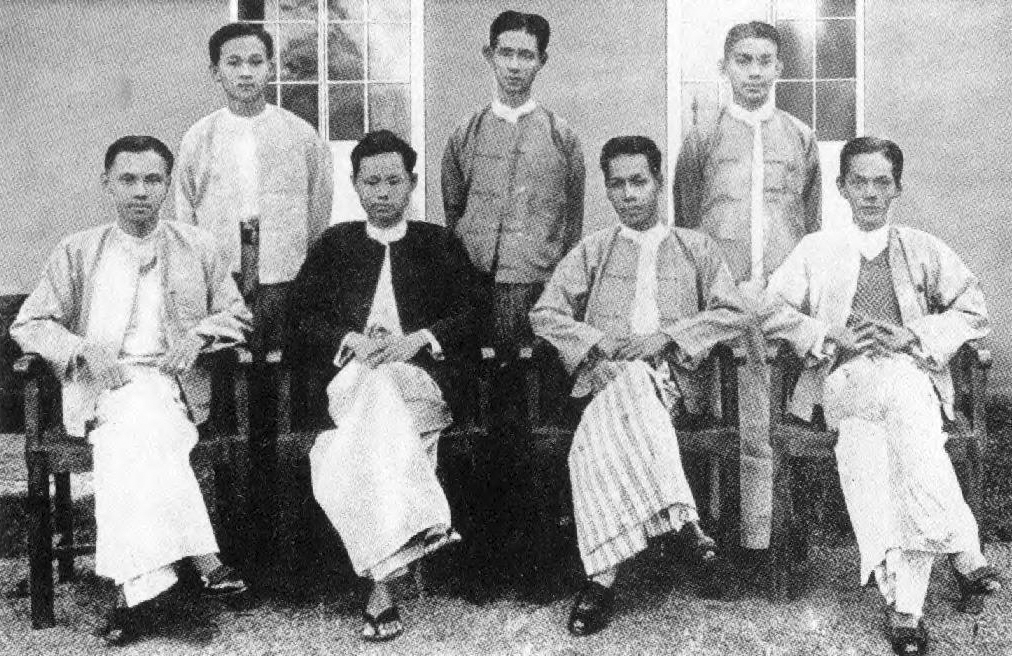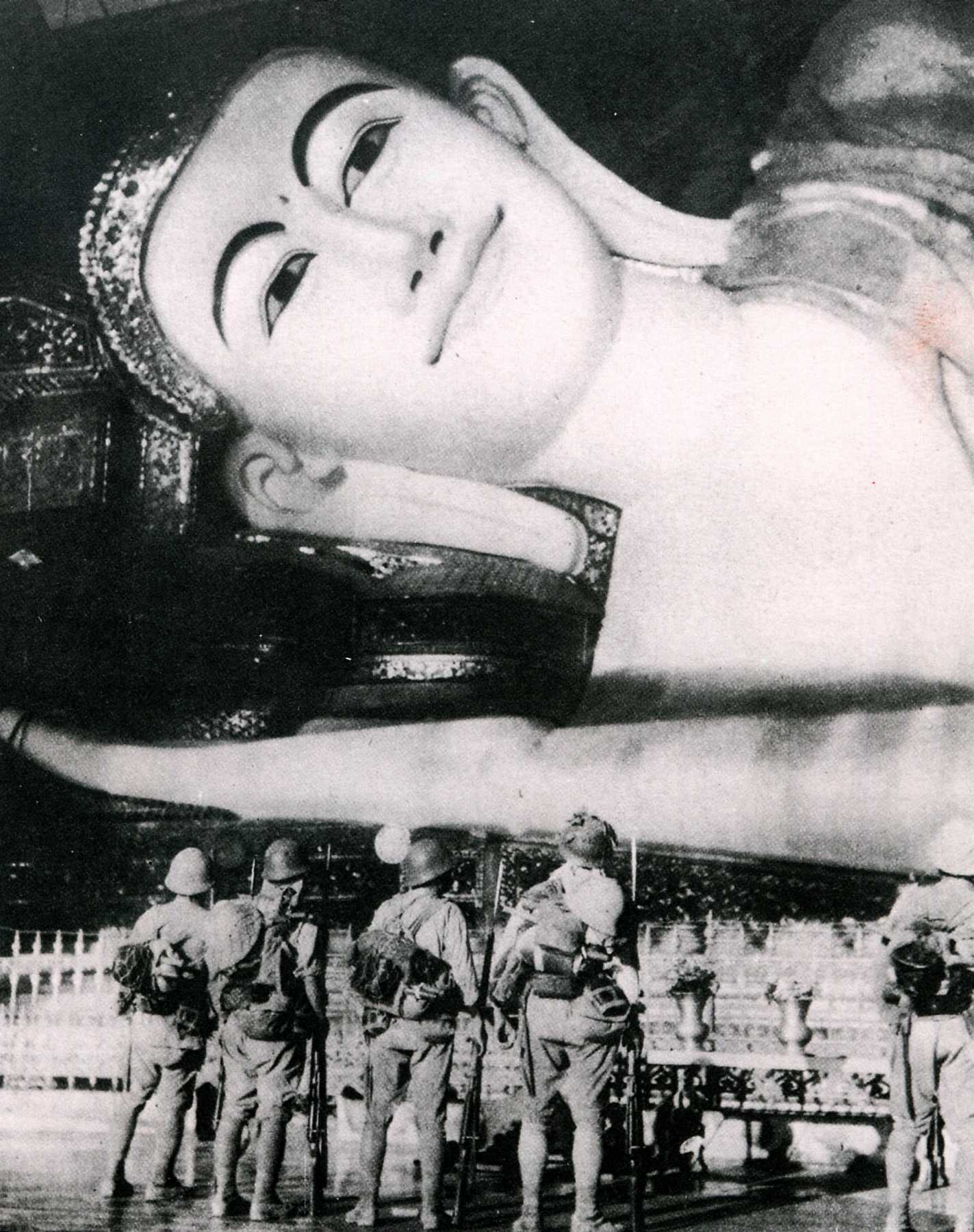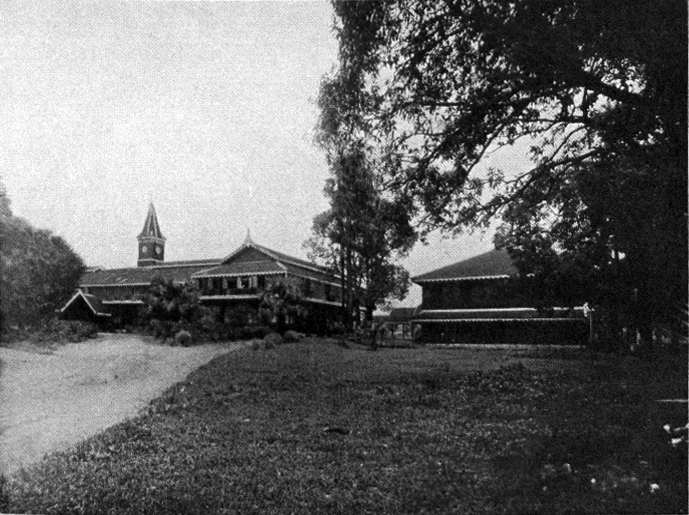|
Thakins
Dobama Asiayone ( my, တို့ဗမာအစည်းအရုံး, ''Dóbăma Ăsì-Ăyòun'', meaning ''We Burmans Association'', DAA), commonly known as the Thakhins ( my, သခင် ''sa.hkang'', lit. Lords), was a Burmese nationalist group formed around the 1930s and composed of young, disgruntled intellectuals. Drawing their name from the way in which the British were addressed during colonial times, the party was established by Ba Thaung in May 1930, bringing together traditionalist Buddhist nationalist elements and fresh political ideals. It was significant in stirring up political consciousness in Burma, and drew most of its support base from students. The party's song, ''Myanmar Kaba Ma Kyei'' ("Till The End of the World, Burma") also became the country's first national song and eventually its national anthem. Composed by Saya Tin (later known as "Thakhin Tin"), the song was a national symbol during the Japanese occupation of Burma and was adopted in 1948 upo ... [...More Info...] [...Related Items...] OR: [Wikipedia] [Google] [Baidu] |
Aung San
Aung San (, ; 13 February 191519 July 1947) was a Burmese politician, independence activist and revolutionary. He was instrumental in Myanmar's struggle for independence from British rule, but he was assassinated just six months before his goal was realized. Aung San is considered the founder of modern-day Myanmar and the Tatmadaw (the country's armed forces), and is commonly referred to by the titles "Father of the Nation", "Father of Independence", and "Father of the Tatmadaw". Devoted to ending British Colonial rule in Burma, Aung San founded or was closely associated with many Burmese political groups and movements and explored various schools of political thought throughout his life. He was a life-long anti-imperialist and studied socialism as a student. In his first year of university he was elected to the executive committee of the Rangoon University Students' Union and served as the editor of its newspaper. He joined the Thakin Society in 1938 and served as its gener ... [...More Info...] [...Related Items...] OR: [Wikipedia] [Google] [Baidu] |
Kaba Ma Kyei
"" ( my-Mymr, ကမ္ဘာမကျေ, ; ), officially called the National Anthem ( my-Mymr, နိုင်ငံတော်သီချင်း, link=no; ''State Anthem''), is the national anthem of Myanmar. It consists of two parts; the first half is a Music of Burma, traditional Burmese style section, before transitioning into the second half, a Western world, Western-style orchestra. A long-standing tradition is that those who sing the national anthem bow at the end, as a show of respect for the nation. History Pre-colonial Burma did not have a proper national anthem, but had compositions glorifying the king. After the annexation of Burma by the British Raj in 1886, "God Save the King" became the national anthem of British rule in Burma, British Burma. In 1930, a musician from Mandalay named Saya Tin went to Rangoon and contacted the Thakins to write a new national anthem together. They set four criteria for the anthem: it must include the background of Burmese history ... [...More Info...] [...Related Items...] OR: [Wikipedia] [Google] [Baidu] |
Japanese Occupation Of Burma
The Japanese occupation of Burma was the period between 1942 and 1945 during World War II, when Burma was occupied by the Empire of Japan. The Japanese had assisted formation of the Burma Independence Army, and trained the Thirty Comrades, who were the founders of the modern Armed Forces (''Tatmadaw''). The Burmese hoped to gain support of the Japanese in expelling the British, so that Burma could become independent.Micheal Clodfelter. Warfare and Armed Conflicts: A Statistical Reference to Casualty and Other Figures, 1500–2000. 2nd Ed. 2002 . p. 556Werner Gruhl, Imperial Japan's World War Two, 1931–1945 Transaction 2007 (Werner Gruhl is former chief of NASA's Cost and Economic Analysis Branch with a lifetime interest in the study of the First and Second World Wars.) In 1942, Japan invaded Burma and nominally declared the colony independent as the ''State of Burma'' on 17 May 1942. A puppet government led by Ba Maw was installed. However, many Burmese began to believe the ... [...More Info...] [...Related Items...] OR: [Wikipedia] [Google] [Baidu] |
Bamar People
The Bamar (, ; also known as the Burmans) are a Sino-Tibetan languages, Sino-Tibetan ethnic group native to Myanmar (formerly Burma) in Southeast Asia. With approximately 35 million people, the Bamar make up the largest ethnic group in Myanmar, constituting 68% of the country's population. The geographic homeland of the Bamar is the Irrawaddy River, Irrawaddy River basin. Burmese language, Burmese is the native language of the Bamar, as well as the national language and lingua franca of Myanmar. Ethnonyms In the Burmese language, Bamar (ဗမာ, also transcribed Bama) and Myanmar (မြန်မာ, also transliterated Mranma and transcribed Myanma) have historically been interchangeable Endonym and exonym, endonyms. Burmese is a Diglossia, diglossic language; "Bamar" is the diglossic low form of "Myanmar," which is the diglossic high equivalent. The term "Myanmar" is extant to the early 1100s, first appearing on a stone inscription, where it was used as a cultural identi ... [...More Info...] [...Related Items...] OR: [Wikipedia] [Google] [Baidu] |
Bamar
The Bamar (, ; also known as the Burmans) are a Sino-Tibetan ethnic group native to Myanmar (formerly Burma) in Southeast Asia. With approximately 35 million people, the Bamar make up the largest ethnic group in Myanmar, constituting 68% of the country's population. The geographic homeland of the Bamar is the Irrawaddy River basin. Burmese is the native language of the Bamar, as well as the national language and lingua franca of Myanmar. Ethnonyms In the Burmese language, Bamar (ဗမာ, also transcribed Bama) and Myanmar (မြန်မာ, also transliterated Mranma and transcribed Myanma) have historically been interchangeable endonyms. Burmese is a diglossic language; "Bamar" is the diglossic low form of "Myanmar," which is the diglossic high equivalent. The term "Myanmar" is extant to the early 1100s, first appearing on a stone inscription, where it was used as a cultural identifier, and has continued to be used in this manner. From the onset of British colonial r ... [...More Info...] [...Related Items...] OR: [Wikipedia] [Google] [Baidu] |
Thakhin Ant Gyi
Dobama Asiayone ( my, တို့ဗမာအစည်းအရုံး, ''Dóbăma Ăsì-Ăyòun'', meaning ''We Burmans Association'', DAA), commonly known as the Thakhins ( my, သခင် ''sa.hkang'', lit. Lords), was a Burmese nationalist group formed around the 1930s and composed of young, disgruntled intellectuals. Drawing their name from the way in which the British were addressed during colonial times, the party was established by Ba Thaung in May 1930, bringing together traditionalist Buddhist nationalist elements and fresh political ideals. It was significant in stirring up political consciousness in Burma, and drew most of its support base from students. The party's song, ''Myanmar Kaba Ma Kyei'' ("Till The End of the World, Burma") also became the country's first national song and eventually its national anthem. Composed by Saya Tin (later known as "Thakhin Tin"), the song was a national symbol during the Japanese occupation of Burma and was adopted in 1948 u ... [...More Info...] [...Related Items...] OR: [Wikipedia] [Google] [Baidu] |
Thakhin Hla Tin
Dobama Asiayone ( my, တို့ဗမာအစည်းအရုံး, ''Dóbăma Ăsì-Ăyòun'', meaning ''We Burmans Association'', DAA), commonly known as the Thakhins ( my, သခင် ''sa.hkang'', lit. Lords), was a Burmese nationalist group formed around the 1930s and composed of young, disgruntled intellectuals. Drawing their name from the way in which the British were addressed during colonial times, the party was established by Ba Thaung in May 1930, bringing together traditionalist Buddhist nationalist elements and fresh political ideals. It was significant in stirring up political consciousness in Burma, and drew most of its support base from students. The party's song, ''Myanmar Kaba Ma Kyei'' ("Till The End of the World, Burma") also became the country's first national song and eventually its national anthem. Composed by Saya Tin (later known as "Thakhin Tin"), the song was a national symbol during the Japanese occupation of Burma and was adopted in 1948 u ... [...More Info...] [...Related Items...] OR: [Wikipedia] [Google] [Baidu] |
Thakhin Mya
Dobama Asiayone ( my, တို့ဗမာအစည်းအရုံး, ''Dóbăma Ăsì-Ăyòun'', meaning ''We Burmans Association'', DAA), commonly known as the Thakhins ( my, သခင် ''sa.hkang'', lit. Lords), was a Burmese nationalist group formed around the 1930s and composed of young, disgruntled intellectuals. Drawing their name from the way in which the British were addressed during colonial times, the party was established by Ba Thaung in May 1930, bringing together traditionalist Buddhist nationalist elements and fresh political ideals. It was significant in stirring up political consciousness in Burma, and drew most of its support base from students. The party's song, ''Myanmar Kaba Ma Kyei'' ("Till The End of the World, Burma") also became the country's first national song and eventually its national anthem. Composed by Saya Tin (later known as "Thakhin Tin"), the song was a national symbol during the Japanese occupation of Burma and was adopted in 1948 ... [...More Info...] [...Related Items...] OR: [Wikipedia] [Google] [Baidu] |
1936 Burmese General Election
General elections were held in Burma on 26 November 1936. The Government of Burma Act 1935 separated Burma from British India as of 1 April 1937, and created a 36-seat Senate and a 132-seat House of Representatives."Legislature and Electors Burma at the Polls", The Times, 20 April 1937, p37, Issue 47663 The pro-constitution United GCBA of U Ba Pe emerged as the largest bloc in the House of Representatives, winning 46 seats. However, few parties were willing to work with U Ba Pe,"Divided Burma: Launching The Constitution", ''The Times'', 11 February 1937, p13, Issue 47606 and the Governor invited Ba Maw to form a government,"Burma On Her Own First Year Of Separation, State In The Making", ''The Times'', 14 April 1938, p13, Issue 47969 despite his Poor Man's Party winning only 16 seats. Maw became Chief Minister after forming a coalition with Chit Hlaing and other "moderate extremists"."The Imperial Conference Opening Speeches, Expressions Of Common Loyalty ", ''The Times'', 15 Ma ... [...More Info...] [...Related Items...] OR: [Wikipedia] [Google] [Baidu] |
Paramilitary
A paramilitary is an organization whose structure, tactics, training, subculture, and (often) function are similar to those of a professional military, but is not part of a country's official or legitimate armed forces. Paramilitary units carry out duties that a country's military or police forces are unable or unwilling to handle. Other organizations may be considered paramilitaries by structure alone, despite being unarmed or lacking a combat role. Overview Though a paramilitary is, by definition, not a military, it is usually equivalent to a light infantry force in terms of strength, firepower, and organizational structure. Paramilitaries use "military" equipment (such as long guns and armored personnel carriers; usually military surplus resources), skills (such as battlefield medicine and bomb disposal), and tactics (such as urban warfare and close-quarters combat) that are compatible with their purpose, often combining them with skills from other relevant fields such a ... [...More Info...] [...Related Items...] OR: [Wikipedia] [Google] [Baidu] |
University Of Yangon
'') , mottoeng = There's no friend like wisdom. , established = , type = Public , rector = Dr. Tin Mg Tun , undergrad = 4194 , postgrad = 5748 , city = Kamayut 11041, Yangon , state = Yangon Region , country = Myanmar , coordinates = , campus = Urban , former_names = , website = , , faculty = 1313 , affiliations = ASEAN University Network (AUN), ASAIHL The University of Yangon (also Yangon University; my, ရန်ကုန် တက္ကသိုလ်, ; formerly Rangoon College, Rangoon University and Rangoon Arts and Sciences University), located in Kamayut, Yangon, is the oldest university in Myanmar's modern education system and the best known university in Myanmar. The university offers mainly undergraduate and postgraduate degrees (Bachelor's, Master's, Post-graduate Diploma, and Doctorate) programs in liberal arts, sciences and law. Full-time bachelor's degrees were not offered at the ... [...More Info...] [...Related Items...] OR: [Wikipedia] [Google] [Baidu] |
Ba Thaung
BA, Ba, or ba may refer to: Businesses and organizations * Bangladesh Army * Bibliotheca Alexandrina, an Egyptian library and cultural center * Boeing (NYSE stock symbol BA) * Booksellers Association of the UK and Ireland * Boston Acoustics, an audio equipment manufacturer * Boston and Albany Railroad (reporting mark BA) * British Aircraft Manufacturing * British Airways (IATA airline code BA) * British-American Oil, a Canadian petroleum company * British Association for the Advancement of Science * The Nottingham Bluecoat Academy, a Church of England secondary school in Nottingham, England * Selskap med begrenset ansvar, a type of Norwegian company with limited liability * Bundesagentur für Arbeit, Federal Employment Agency of Germany Languages * Bashkir language (ISO 639 alpha-2 language code BA) * Ba (Javanese) (ꦧ), a letter in the Javanese script * Baa language, a Niger-Congo language * Aka-Bo language, an Indian language, also known as ''Ba'' * Arabic letter ب, named ... [...More Info...] [...Related Items...] OR: [Wikipedia] [Google] [Baidu] |







